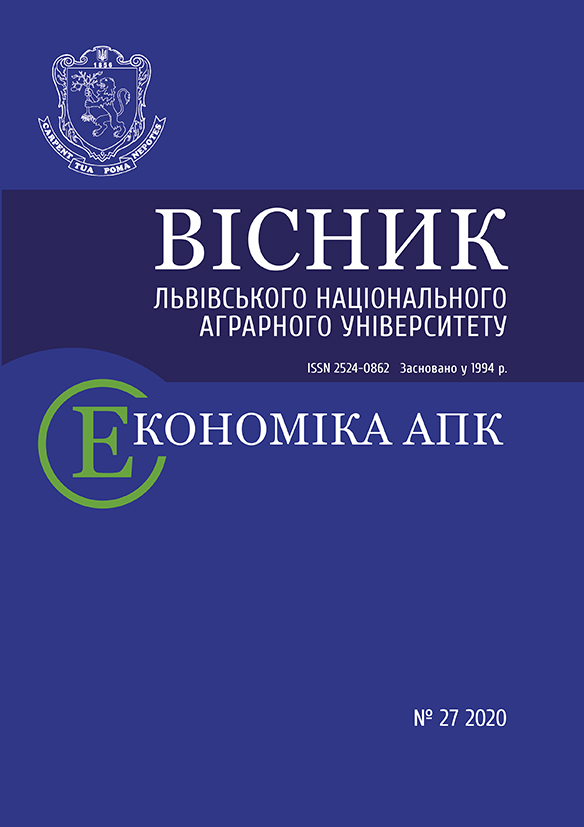Visnyk LNAU: Agronomy 2020 №24: 38-44
Scientifically substantiated short crop rotations in the systems of arable farming in the Carpathian region
O. Kachmar, Candidate of Agricultural Sciences
ORCID ID: 0000-0002-0382-6030
O. Vavrynovych, Candidate of Agricultural Sciences
ORCID ID: 0000-0003-3466-1432
O. Dubytskyi, Candidate of Biological Sciences
ORCID ID: 0000-0002-8293-4119
A. Dubytska, Candidate of Agricultural Sciences
ORCID ID: 0000-0002-5685-0237
M. Shcherba, research scholar
ORCID ID: 0000-0002-0773-6382
Institute of Agriculture of Carpathian region of the NAAS
Vovk A. І., Candidate of Engineering Sciences
ORCID ID: 0000-0002-0445-1947
Lviv Polytechnic National University
https://doi.org/10.31734/agronomy2020.01.038
Annotation
The results of long-term stationary studies substantiate the influence of traditional organic-mineral and alternative (with the use of straw and siderate on moderate mineral backgrounds) fertilization systems on the formation of humus soil regime, nutrient balance, and crop rotation productivity. It is established that the highest values of unstable organic matter under winter wheat crops are formed in fruit-bearing and grain-forage crop rotations and, depending on the fertilization systems, indicators of labile humus are in the range of 411.36–467.07 mg/100 g (fruit-bearing) and 481.12–521.47 mg/100 g (grain-forage), water-soluble one - 14.46–18.52 and 19.55–20.46 mg/100 g of soil respectively. It is argued that application of 8-10 tons of manure and mineral fertilizers at a rate of N45-69P60-77K60-77 per one hectare of crop rotation area, as well as reduction of their volume twice with plowing of siderate and by-products provides a positive balance of nitrogen, phosphorus and potassium in all studied crop rotations. The highest yield of grain units was obtained in grain crop rotations when 10 ha/ha of manure combined with mineral fertilizers in rates of N51,2-66,2Р66,2-68,7К66,2-68,7 (4.00–4.41 t/ha and 3.17–3.60 t/ha). The maximum yield of fodder units was obtained in fruit-bearing (5.94–6.96 t/ha depending on the fertilization system) and grain-forage (5.46–6.56 t/ha) crop rotations. Application of 8–10 t of manure and mineral fertilizers at a rate of N45-69P60-77K60-77, per one hectare of crop rotation area, as well as their reduction in half by plowing of siderate and by-products in short rotational crop rotations ensures a high level of their productivity, a positive balance of the basic elements plant nutrition. It also activates humus-forming processes in the soil and promotes accumulation of unstable humus substances.Key words
crop rotation, productivity, fertilization systems, soil fertility
Link
- Boyko P. I., Kovalenko N. P., Opara M. M. Effective relations with the population in the land district. Visnyk Poltavskoi derzhavnoi ahrarnoi akademii Bulletin of Poltava State Agrarian Academy. 2014. № 3. Р. 20–32. [in Ukrainіan].
- Boyko P. I., Litvinov D. V. The effectiveness of short rotation rotations in modern farming systems. Proceedings of the Scientific Research Center of the NAAS Institute of Agriculture. 2015. Vol. 45. P. 42–55. [in Ukrainіan]
- Degodyuk S. E., Litvinova O. A., Bodnar Y. D. (2016) Influence of long-term use of fertilizers in crop rotation on changes of potential and effective fertility of gray forest soil. Agriculture: Intersectionality. theme. of sciences. Sat. 2016. Vol. 1. P. 43–48. [in Ukrainіan] https://doi.org/10.31073/zem.90.43-48
- Degodyuk S. E., Litvinova O. A., Kirichenko A. V. Nutrient balance for long-term use of fertilizers in grain-crop rotation. Bulletin of agrarian science. 2014. № 7 (737). Р. 16–19. [in Ukrainіan].
- Formation of rotation as a means of preventing degradation and increasing soil fertility in the Carpathian region / Kachmar O. J. et al. Agriculture: Intersectionality. theme. of sciences. Sat. 2018. Vol. 2. P. 20–25. [in Ukrainіan] https://doi.org/10.31073/zem.95.20-25
- Gadzalo Ya. M., Kaminsky V. F., Saiko V. F. (2015) Crop rotations in agriculture of Ukraine. Agriculture: Intersectionality. theme. of sciences. Sat. 2015. Vol. 1. P. 3–6. [in Ukrainіan]
- Kaminsky V. F. Sivozmin as the basis of sustainable land use and food security of Ukraine. Proceedings of the Scientific Research Center of the NAAS Institute of Agriculture. 2015. Vol. 2. P. 3–13. [in Ukrainіan].
- Tkachenko M. A., Litvinov D. V. Productivity of typical forest steppes depending on the intensity of agronomic loading. Scientific papers of the Institute of bioenergy crops and sugar beet. Vol. 22. P. 100–106. [in Ukrainіan]
- Tsvey Ya. P., Gorobets A. M. (2006) The productivity of short rotation crop rotations in the Forest-Steppe of Ukraine. Sugar beet. № 6. P. 10–11.
- Yeshchenko V. A. The role of crop rotation in modern agriculture. Agriculture: Intersectionality. theme. of sciences. Sat. 2015. Vol. 1. P. 23–27. [in Ukrainіan].



